SSZT574 december 2018 TPS92692-Q1
Daytime running lights (DRLs) are becoming more popular in vehicles and are even a requirement in some countries. As I’m sure you can guess, DRLs are on during the day, which requires them to be very bright.
As a designer, you typically have two choices to achieve the desired DRL LED brightness:
- Increase the number of LEDs in your string, which results in a much higher LED driver output voltage.
- Use two LED drivers to enable a lower LED driver output voltage.
Automotive Daytime Running Light Dual String LED Driver Reference Design with Current Balancing outlines an effective way to drive parallel strings of LEDs for DRL applications without adding a second LED driver. In the first installment of this two-part series, I’ll take a brief look at this reference design and investigate how to add one-fail-all-fail LED fault detection.
Reference Design Overview
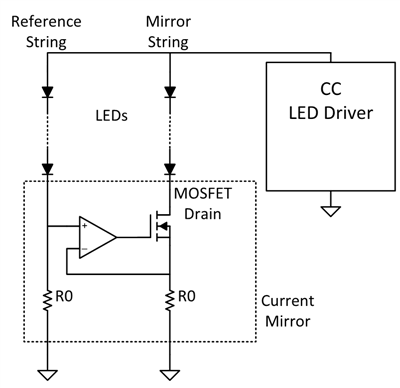 Figure 1 Current-balancing Circuit
Figure 1 Current-balancing CircuitOne-fail-all-fail LED Fault Detection
- How is a fault detected?
- If a fault occurs, how do you shut off all of the LEDs?
How to Detect a Fault
- An LED short in the mirror string.
- An LED short in the reference string.
- An open circuit in the mirror string.
- An open circuit in the reference string.
To understand how to detect these faults, let’s first analyze how the circuit operates under normal operation; see Figure 2.
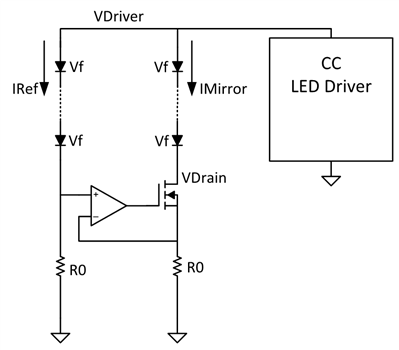 Figure 2 Current-balancing Circuit under Normal Operation (Vf Is the Forward Voltage of One LED)
Figure 2 Current-balancing Circuit under Normal Operation (Vf Is the Forward Voltage of One LED)Because there is one more LED in the reference string than the mirror string, and the currents IRef and IMirror are equal, you can use Equations 1 and 2 to define VDriver:
VDriver = (# of LEDs in reference string) × Vf + IRef × R0 (1)
VDriver = (# of LEDs in mirror string) × Vf + IMirror × (MOSFET RDSon + R0) (2)
Now you can use Equations 3, 4 and 5 to define VDrain:
VDrain = VDriver - (# of LEDs in mirror string) × Vf (3)
# of LEDs in mirror string = (# of LEDs in reference string) - 1 (4)
Using Equations 1 and 2:
VDrain = IMirror × (MOSFET RDSon + R0) = Vf + IMirror × R0 (5)
You can now analyze the circuit under different fault conditions.
An LED Short in the Mirror String
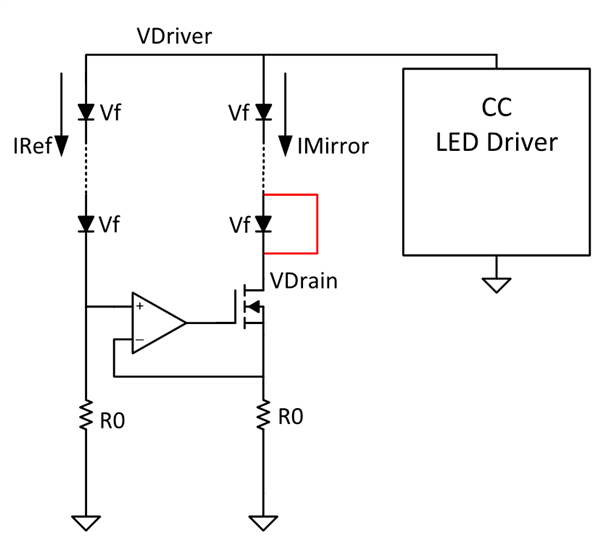 Figure 3 LED Short in the Mirror String
Figure 3 LED Short in the Mirror StringAn LED Short in the Reference String
Figure 4 depicts the condition where an LED is shorted in the reference string.
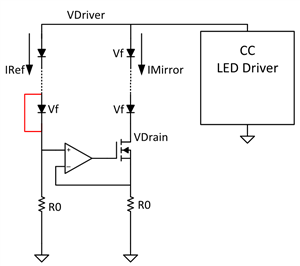 Figure 4 LED Short in the Reference String
Figure 4 LED Short in the Reference StringAn Open Circuit in the Mirror String
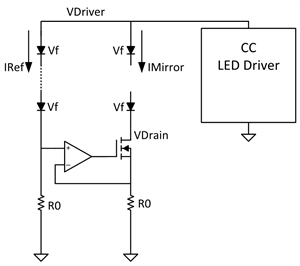 Figure 5 Open Circuit in the Mirror String
Figure 5 Open Circuit in the Mirror StringAn Open Circuit in the Reference String
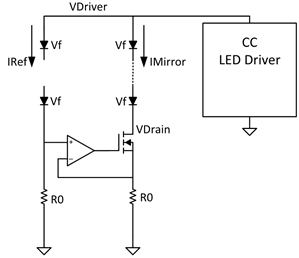 Figure 6 Open Circuit in the Reference String
Figure 6 Open Circuit in the Reference StringA negative input offset voltage indicates that the inverting input of the op amp is at a higher potential than the noninverting input and the op-amp output would saturate to its negative supply rail. Thus, the MOSFET would be driven to its off state. However, the LED driver will continue to increase its output voltage in order to drive the current through the mirror string – and because the MOSFET RDSon is modeled as a resistor in parallel with the MOSFET drain and source, a small amount of current will be able to flow. This will cause the MOSFET drain voltage to increase until the LED driver triggers an overvoltage condition. According to the TPS92692-Q1 data sheet, the device would stop sourcing current once the OV limit has been hit, the soft-start will be triggered again once the output voltage drops over a set hysteresis and then begin switching. This results in VDrain oscillating between ~60 V and 0 V with a period of the timing that voltage drops over hysteresis plus the soft-start time.”
A positive-input offset voltage indicates that the noninverting input of the op amp is at a higher potential than the inverting input and that the op amp would saturate to its positive supply rail. With an open circuit in the reference string and all of the current flowing through the mirror string, the voltage at the inverting input would be greater than the voltage at the noninverting input, and the op-amp output would saturate to the negative supply rail. This results in high-frequency oscillations at the output of the amplifier, and thus VDrain oscillations between ~30 V and 0 V.
Find out how to respond when a fault is detected in part two.